Simple Hybrid Camera-Based System Using Two Views for Three-Dimensional Body Measurements
Abstract
:1. Introduction
Article’s Organisation
2. Background
2.1. Traditional Measurements
2.2. Recent Computerised Methods
2.3. Deep Learning Methods
2.4. Overview of the Current Situation in the Fashion and Retail Industry
2.5. Challenges and Motivations: Existing Body Sizing Applications
3. Method
3.1. Body Parts via ROIs
3.2. Image Corrections and Processing
Regional Skin Detection
3.3. Selecting Markers
3.4. Computing the Perimeter of Fitted Ellipses
3.5. Camera Calibration
4. Result and Discussion
- Choosing Participant Selection:
- Ground truth:
4.1. Ellipse Model Results
4.2. Final Results
- With a plain background;
- With a cluttered or textured background;
- Using a pair of different body postures (A-pose and relax pose);
- Using different distances from the camera;
- With clothing that has visible creases;
- Under different lighting conditions;
- Using devices with different camera specifications:
- (a)
- Apple devices;
- (b)
- Samsung devices.
5. Conclusions
Author Contributions
Funding
Institutional Review Board Statement
Informed Consent Statement
Data Availability Statement
Acknowledgments
Conflicts of Interest
Appendix A
| Title | Measurement Type | Title | Measurement Type |
|---|---|---|---|
| opx | Chest/bust girth | opn | Neck girth |
| opp | Under chest/bust girth | oph | Wrist girth |
| ot | Waist girth | SvRv | Shoulder length |
| ob | Hips girth | SyTy | Back length |
Appendix A.1. Error Correlation for the Five Existing Apps in Detail


Appendix A.2. Data Collection and Dataset Segmentation
| Measure | MobileNet SSD |
|---|---|
| Precision | 0.79 |
| Recall | 0.54 |
| F1-score | 0.61 |
| mAP@.5 | 0.70 |
| mAP@.5:95 | 0.55 |
| Inference time (ms) | 8.4 |
Appendix A.3. Calculation of an Ellipse Perimeter

References
- Tomi, B.; Sunar, M.S.; Mohamed, F.; Saitoh, T.; Bin Mokhtar, M.K.; Luis, S.M. Dynamic Body Circumference Measurement Technique for a More Realistic Virtual Fitting Room Experience. In Proceedings of the IEEE Conference on e-Learning, e-Management and e-Services (IC3e), Langkawi, Malaysia, 21–22 November 2018; pp. 56–60. [Google Scholar] [CrossRef]
- Xiaohui, T.; Xiaoyu, P.; Liwen, L.; Qing, X. Automatic human body feature extraction and personal size measurement. J. Vis. Lang. Comput. 2018, 47, 9–18. [Google Scholar] [CrossRef]
- Chang, H.T.; Li, Y.W.; Chen, H.T.; Feng, S.Y.; Chien, T.T. A Dynamic Fitting Room Based on Microsoft Kinect and Augmented Reality Technologies. In Human-Computer Interaction, Interaction Modalities and Techniques, Proceedings of the 15 International Conference, HCI International 2013, Las Vegas, NV, USA, 21–26 July 2013; Kurosu, M., Ed.; Springer: Berlin/Heidelberg, Germany, 2013; pp. 177–185. [Google Scholar] [CrossRef]
- Chandra, R.N.; Febriyan, F.; Rochadiani, T.H. Single Camera Body Tracking for Virtual Fitting Room Application. In Proceedings of the 10th International Conference on Computer and Automation Engineering, ICCAE, ACM, Brisbane, Australia, 24–26 February 2018; pp. 17–21. [Google Scholar] [CrossRef]
- Ashmawi, S.; Alharbi, M.; Almaghrabi, A.; Alhothali, A. FitMe: Body Measurement Estimations Using Machine Learning Method. Procedia Comput. Sci. 2019, 163, 209–217. [Google Scholar] [CrossRef]
- Choudhary, S.; Iyer, G.; Smith, B.M.; Li, J.; Sippel, M.; Criminisi, A.; Heymsfield, S.B. Development and validation of an accurate smartphone application for measuring waist-to-hip circumference ratio. NPJ Digit. Med. 2023, 6, 168. [Google Scholar] [CrossRef] [PubMed]
- Danadoni, F.; Mechan, J.; Johnson, C. “PS for You”’: A Contactless, Remote, Cloud-Based Body Measurement Technology Powered by Artificial Intelligence. In Proceedings of the 12th International Conference and Exhibition on 3D Body Scanning and Processing Technologies (3DBODY.TECH), Lugano, Switzerland, 19–20 October 2021. [Google Scholar] [CrossRef]
- Johnson, C.; Danadoni, F. A Pilot Study Using a Remote, AI-Powered Measurement Technology to Enable a Decentralised Production System, from Ideation to Delivery. In Proceedings of the 13th International Conference and Exhibition on 3D Body Scanning and Processing Technologies (3DBODY.TECH), Lugano, Switzerland, 25–26 October 2022. [Google Scholar] [CrossRef]
- Kaashki, N.N.; Hu, P.; Munteanu, A. Anet: A Deep Neural Network for Automatic 3D Anthropometric Measurement Extraction. IEEE Trans. Multimed. 2023, 25, 831–844. [Google Scholar] [CrossRef]
- Choutas, V.; Müller, L.; Huang, C.H.P.; Tang, S.; Tzionas, D.; Black, M.J. Accurate 3D Body Shape Regression using Metric and Semantic Attributes. In Proceedings of the IEEE Conference on Computer Vision and Pattern Recognition (CVPR), New Orleans, LA, USA, 18–24 June 2022; Available online: https://shapy.is.tue.mpg.de/ (accessed on 1 September 2022).
- Mogavero, T. Clothed in Conservation: Fashion & Water. Sustainable Campus, Florida State University. 2020. Available online: https://sustainablecampus.fsu.edu/blog/clothed-conservation-fashion-water (accessed on 23 July 2020).
- World Wildlife Fund. Threats: Water Scarcity. 2023. Available online: https://www.worldwildlife.org/threats/water-scarcity (accessed on 23 July 2020).
- Brooks, A.L.; Brooks, E.P. Towards an inclusive virtual dressing room for wheelchair-bound customers. In Proceedings of the International Conference on Collaboration Technologies and Systems (CTS), IEEE, Minneapolis, MN, USA, 19–23 May 2014; pp. 582–589. [Google Scholar] [CrossRef]
- PRNewswire. Consumers to Return Half of Online Clothing Purchases This Holiday Season. Technical Report. 2018. Available online: https://www.prnewswire.com/news-releases/consumers-to-return-half-of-online-clothing-purchases-this-holiday-season-300760466.html (accessed on 2 May 2023).
- Halilday, S. Online Fashion Returns Soar as Shoppers Lack Size Info. Technical Report, Fashion Network. 2018. Available online: https://ww.fashionnetwork.com/news/Online-fashion-returns-soar-as-shoppers-lack-size-info,957327.html (accessed on 2 May 2023).
- Inman, D. Retail Returns Increased to $761 Billion in 2021 as a Result of Overall Sales Growth Gradients. Technical Report, National Retail Federation (NRF). 2022. Available online: https://nrf.com/research/customer-returns-retail-industry-2021 (accessed on 2 February 2023).
- Faust, M.E.; Carrier, S. Designing Apparel for Consumers: The Impact of Body Shape and Size; Woodhead Publishing: Sawston, UK, 2014. [Google Scholar]
- ISO 8559-1:2017; Size Designation of Clothes—Part 1: Anthropometric Definitions for Body Measurement. International Organization for Standardization: Geneva, Switzerland, 2017.
- Lucas, T.; Henneberg, M. Use of units of measurement error in anthropometric comparisons. Anthropol. Anz. 2017, 74, 183–192. [Google Scholar] [CrossRef] [PubMed]
- Ulijaszek, S.J.; Kerr, D.A. Anthropometric measurement error and the assessment of nutritional status. Br. J. Nutr. 1999, 82, 165–177. [Google Scholar] [CrossRef] [PubMed]
- Meyer, P.; Birregah, B.; Beauseroy, P.; Grall, E.; Lauxerrois, A. Missing body measurements prediction in fashion industry: A comparative approach. Fash. Text. 2023, 10, 37. [Google Scholar] [CrossRef]
- Howard, A.; Zhu, M.; Chen, B.; Kalenichenko, D.; Wang, W.; Weyand, T.; Andreetto, M.; Adam, H. MobileNets: Efficient Convolutional Neural Networks for Mobile Vision Applications. arXiv 2017, arXiv:1704.04861. [Google Scholar]
- Maragos, P. Morphological filtering for image enhancement and feature detection. In The Image and Video Processing Handbook; CRC Press: Boca Raton, FL, USA, 2005; pp. 135–156. [Google Scholar] [CrossRef]
- Shapiro, L.; Stockman, G. Computer Vision; Prentice Hall: Upper Saddle River, NJ, USA, 2001. [Google Scholar]
- Rajinikanth, V.; Raja, N.S.M.; Dey, N. A Beginner’s Guide to Multilevel Image Thresholding; CRC Press: Boca Raton, FL, USA, 2020. [Google Scholar] [CrossRef]
- Kolkur, S.; Kalbande, D.; Shimpi, P.; Bapat, C.; Jatakia, J. Human Skin Detection Using RGB, HSV and YCbCr Color Models. In Proceedings of the International Conference on Communication and Signal Processing (ICCASP 2016), Lonere, India, 26–27 December 2016; Atlantis Press: Dordrecht, The Netherlands, 2017. [Google Scholar] [CrossRef]
- Yao, J.; Zhang, H.; Zhang, H.; Chen, Q. R&D of a parameterized method for 3D virtual human body based on anthropometry. Int. J. Virtual Real. 2008, 27, 9–12. [Google Scholar]
- Saito, S.; Simon, T.; Saragih, J.; Joo, H. PiFuHD: Multi-Level Pixel-Aligned Implicit Function for High-Resolution 3D Human Digitization. In Proceedings of the IEEE/CVF Conference on Computer Vision and Pattern Recognition (CVPR), Seattle, WA, USA, 13–19 June 2020; pp. 81–90. [Google Scholar] [CrossRef]
- ISO 8559-2; Size Designation of Clothes—Part 2: Primary and Secondary Dimension Indicators. International Organization for Standardization: Geneva, Switzerland, 2017.
- ISO 8559-3; Size Designation of Clothes—Part 3: Methodology for the Creation of Body Measurement Tables and Intervals. International Organization for Standardization: Geneva, Switzerland, 2018.
- 3Dlook.Me. 2023. Available online: https://3dlook.me/ (accessed on 11 December 2023).
- SizeStream. 2023. Available online: https://www.sizestream.com/ (accessed on 11 December 2023).
- Esenca. 2023. Available online: https://www.esenca.app/ (accessed on 11 December 2023).
- Presize. 2023. Available online: www.presize.ai/ (accessed on 12 December 2021).
- TechMed3D. 2023. Available online: https://techmed3d.com/ (accessed on 11 December 2023).
- Berndt, B.C. Ramanujan’s Notebooks: Part I; Springer: New York, NY, USA, 1985. [Google Scholar] [CrossRef]


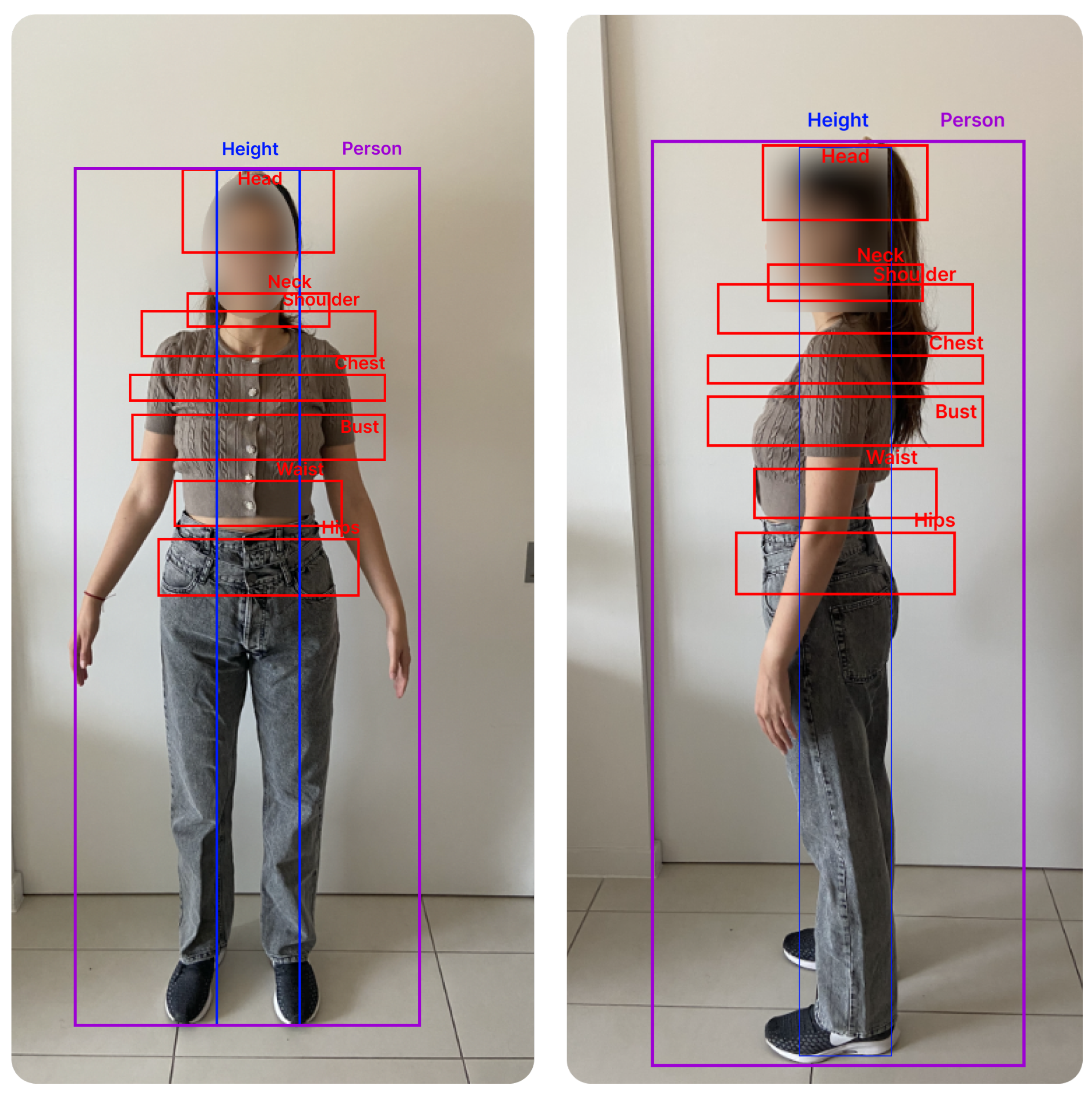
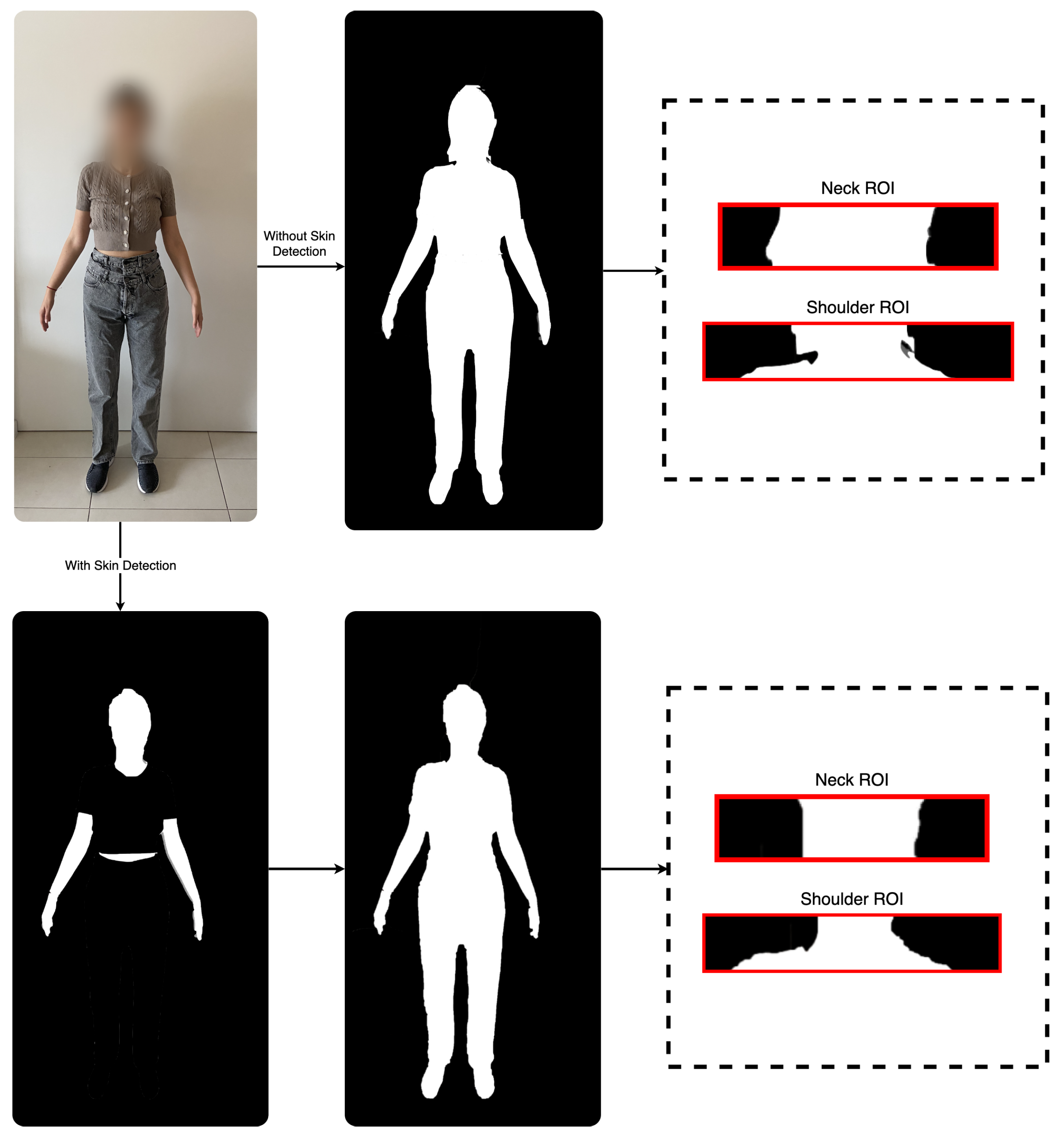
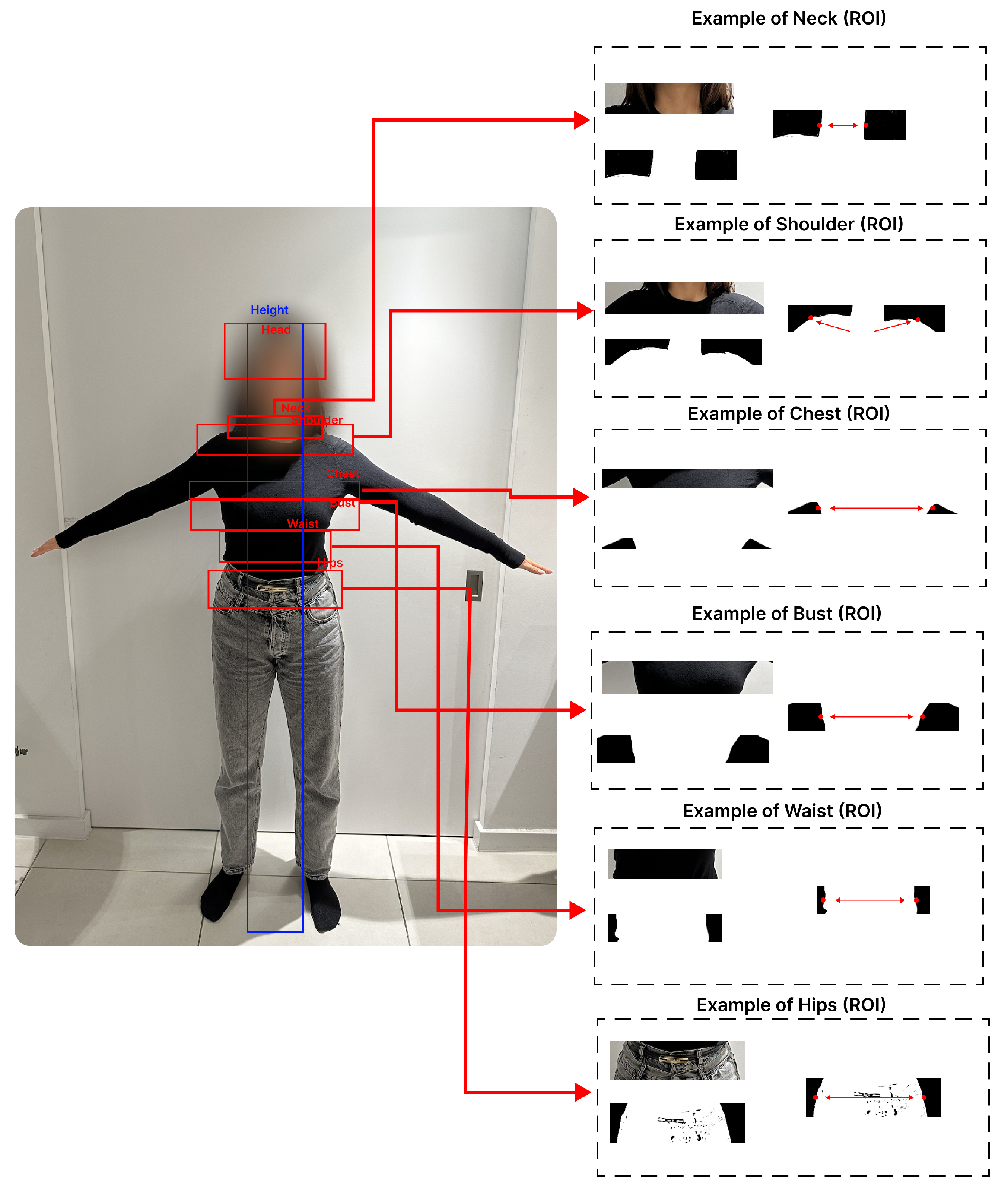

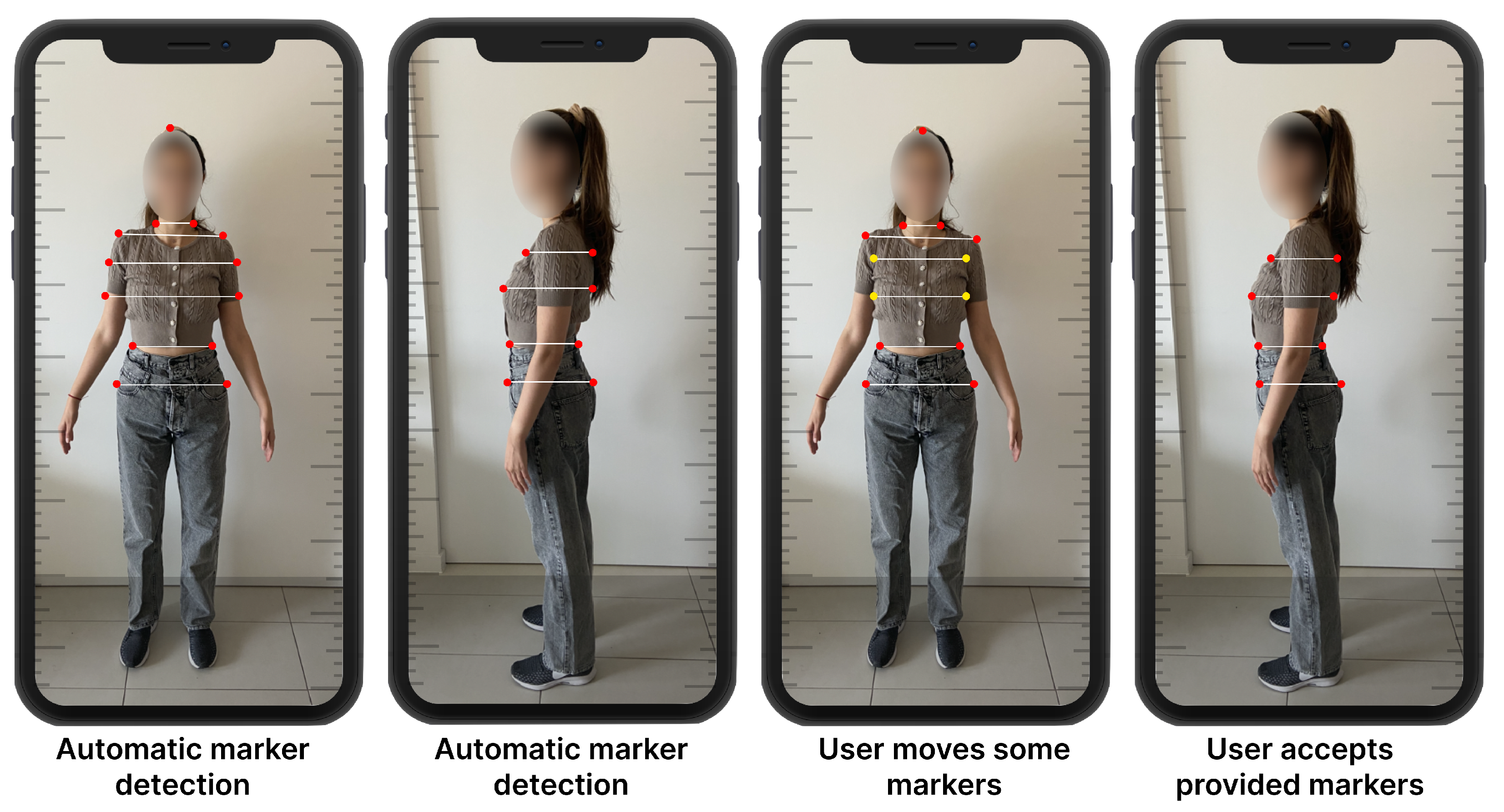
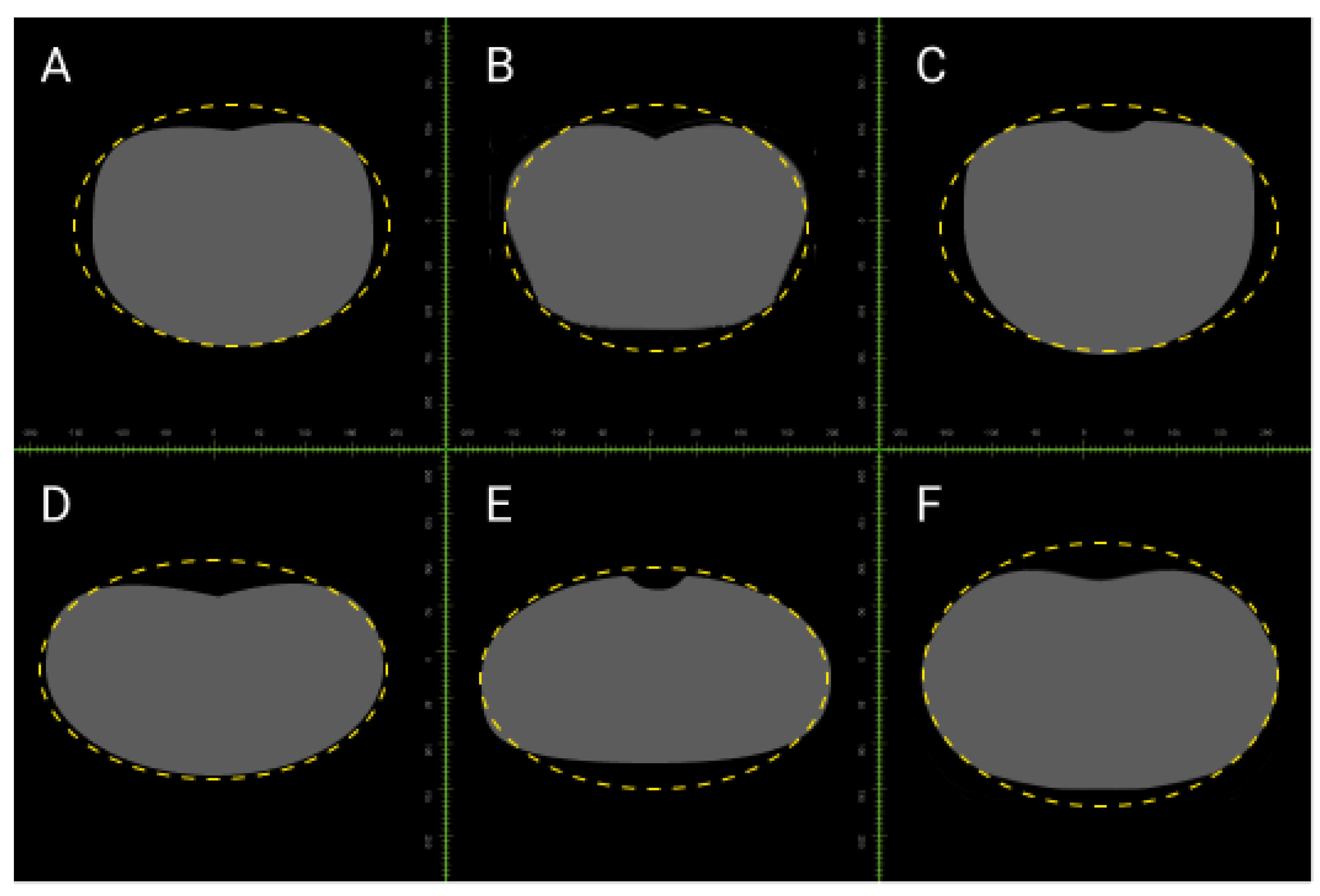



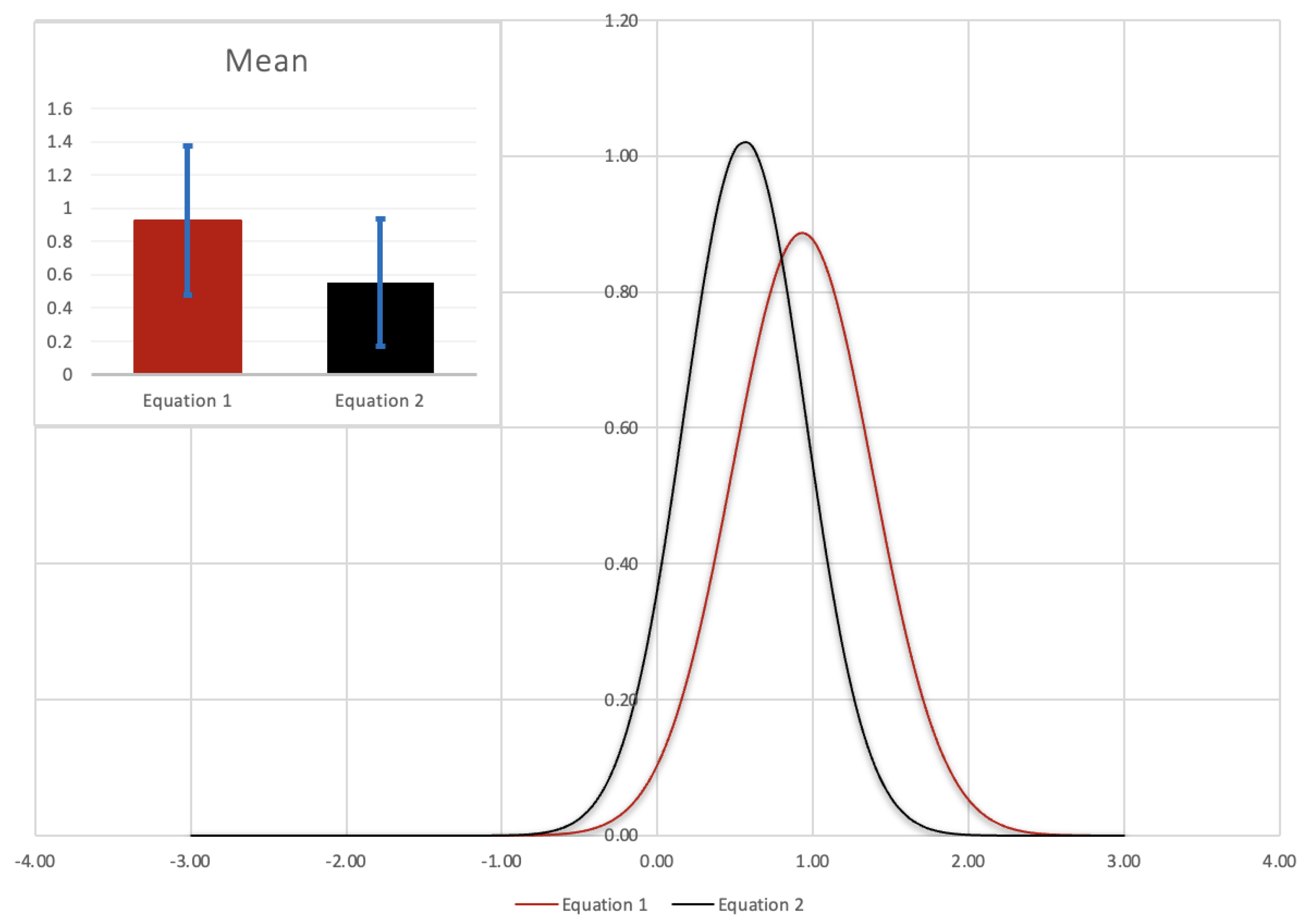


| Body Type | Chest | Bust | Waist | Hips |
|---|---|---|---|---|
| Mean Differences (cm) | 0.78 | 0.78 | 0.96 | 0.78 |
| Median Differences (cm) | 0.76 | 0.76 | 0.82 | 0.76 |
| Max Differences (cm) | 3.14 | 2.66 | 3.19 | 3.82 |
| Min Differences (cm) | 0.01 | 0.01 | 0.02 | 0.02 |
| Standard Deviation (cm) | 0.55 | 0.50 | 0.62 | 0.56 |
Disclaimer/Publisher’s Note: The statements, opinions and data contained in all publications are solely those of the individual author(s) and contributor(s) and not of MDPI and/or the editor(s). MDPI and/or the editor(s) disclaim responsibility for any injury to people or property resulting from any ideas, methods, instructions or products referred to in the content. |
© 2023 by the authors. Licensee MDPI, Basel, Switzerland. This article is an open access article distributed under the terms and conditions of the Creative Commons Attribution (CC BY) license (https://creativecommons.org/licenses/by/4.0/).
Share and Cite
Montazerian, M.; Leymarie, F.F. Simple Hybrid Camera-Based System Using Two Views for Three-Dimensional Body Measurements. Symmetry 2024, 16, 49. https://doi.org/10.3390/sym16010049
Montazerian M, Leymarie FF. Simple Hybrid Camera-Based System Using Two Views for Three-Dimensional Body Measurements. Symmetry. 2024; 16(1):49. https://doi.org/10.3390/sym16010049
Chicago/Turabian StyleMontazerian, Mohammad, and Frederic Fol Leymarie. 2024. "Simple Hybrid Camera-Based System Using Two Views for Three-Dimensional Body Measurements" Symmetry 16, no. 1: 49. https://doi.org/10.3390/sym16010049
APA StyleMontazerian, M., & Leymarie, F. F. (2024). Simple Hybrid Camera-Based System Using Two Views for Three-Dimensional Body Measurements. Symmetry, 16(1), 49. https://doi.org/10.3390/sym16010049






